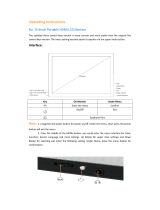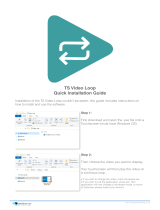
RED EPIC OPERATION GUIDE
COPYRIGHT © 2013 RED.COM, INC
955-0002_v4.0, Rev-A | 11
J. DO NOT expose your camera to excessive vibration or impact (shock). Be careful not to drop your
camera. Internal mechanisms may be damaged by severe shock. Mechanical alignment of optical
elements may be affected by excessive vibration.
K. ELECTROMAGNETIC INTERFERENCE: The use of devices using radio or other communication waves
may result in the malfunction or interference with the unit and/or with audio and video signals.
L. Clean only using a dry cloth. When cleaning your camera, remember that it is not waterproof and
moisture can damage electronic circuitry. DO NOT rinse or immerse any element of the camera, lens or
other accessory, keep them dry at all times. DO NOT use soaps, detergents, ammonia, alkaline cleaners,
and abrasive cleaning compounds or solvents. These substances may damage lens coatings and
electronic circuitry.
M. Maintain sufficient ventilation - DO NOT block any ventilation openings or obstruct cooling fan airflow.
CAUTION: Proper camera ventilation requires a minimum 1/2” (1,25cm) clearance between the camera
ventilation openings and external surfaces. Verify that objects that can block the fan intake and exhaust
ports do not impede airflow. Failure to permit adequate airflow may result in overheating of the camera,
degraded operation and in extreme situations, damage to the camera.
N. DO NOT operate or store near any heat sources such as radiators, heat registers, stoves, or any other
apparatus that produce heat. Store in a protected, level and ventilated place. Avoid exposure to
temperature extremes, damp, severe vibration, strong magnetic fields, direct sunlight or local heat
sources during storage. Remove any batteries from the camera before storage. Recommended storage
and usage temperatures for your camera, lenses and other accessories are:
•
Operating range: 0
°
C to +40
°
C (32
°
F to 104
°
F)
•
Storage range: -20
°
C to +50
°
C (-4
°
F to 122
°
F)
If there are any performance issues with your camera or accessories when operating within this
temperature range, please file a support ticket on
www.RED.com/support
.
O. The Side Handle, Side SSD Module, Rear Modules and Lens Mount are NOT HOT SWAPPABLE –
meaning you cannot remove or install them while the camera is powered on. Before installing or
removing any of these accessories, you MUST power down the camera. Failure to do so may result in
damage to the accessory and / or camera brain that will not be covered under warranty.
P. Do not bypass the third prong of the grounding-type plug on the power cord of the AC Power Adapter. A
grounding-type plug has two blades and a third “grounding” prong. The third prong is provided for your
safety. A grounding-type plug shall be connected to an outlet with a protective earthen connection. If the
grounding-type plug does not fit into your outlet, do not attempt to modify the plug or outlet, consult a
qualified electrician.
Q. Protect all power cords from being pinched, walked on or driven over by a vehicle. Replace any power
cords suspected of sustaining damage due to crushing or other forms physical damage.
CAUTION: The power cord plug for the AC Power Adapter is used as the power disconnect. To disconnect
all power from the AC Power Adapter, unplug the power cord plug from the wall outlet. During use, the
power cord plug should remain easily accessible at all times.
R. Lithium Ion batteries may be subject to special handling requirements pursuant to federal and local laws.
Please refer to specific shipping instructions included with your battery regarding proper transport of
your battery. Do not handle your battery if it is damaged or leaking. Disposal of batteries must be in
accordance with local environmental regulations. For example, California law requires that all
rechargeable batteries must be recycled by an authorized recycle center. Storing batteries fully charged
or in high temperature, conditions may permanently reduce the life of the battery. Available battery
capacity may also be temporarily lessened after storage in low temperature conditions.
WARNING: Do not expose the battery to excessive heat.
























